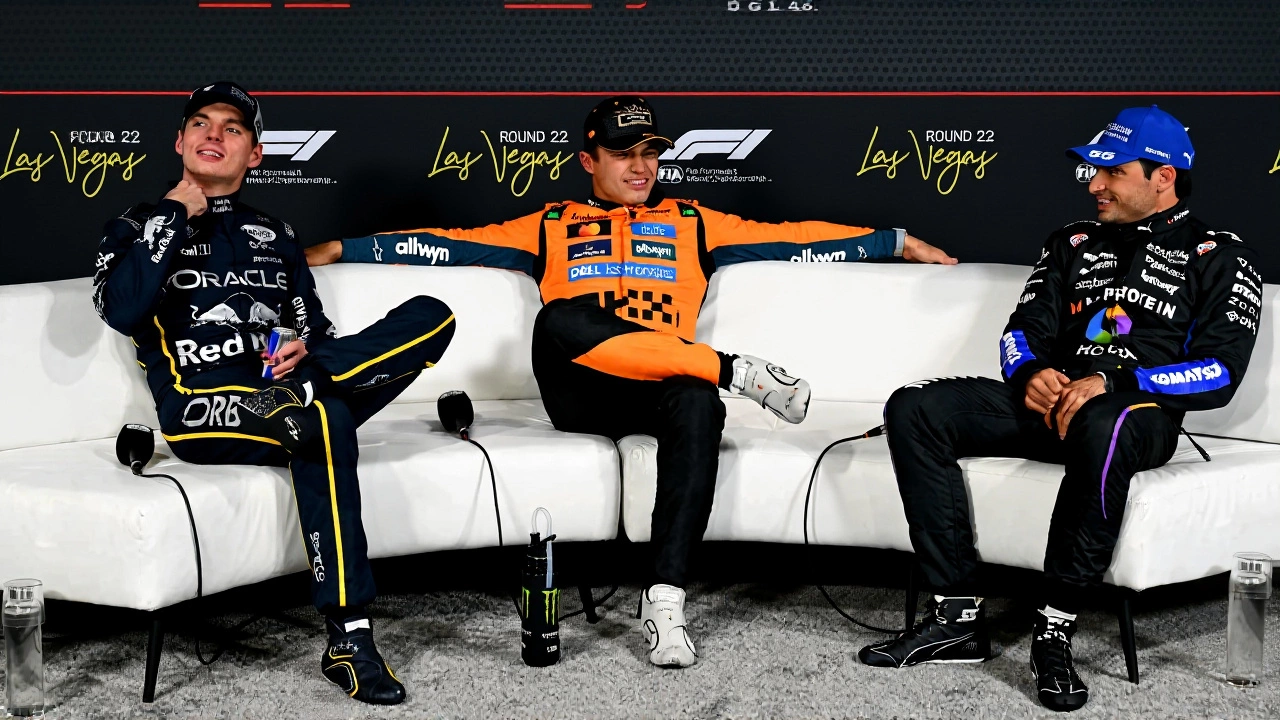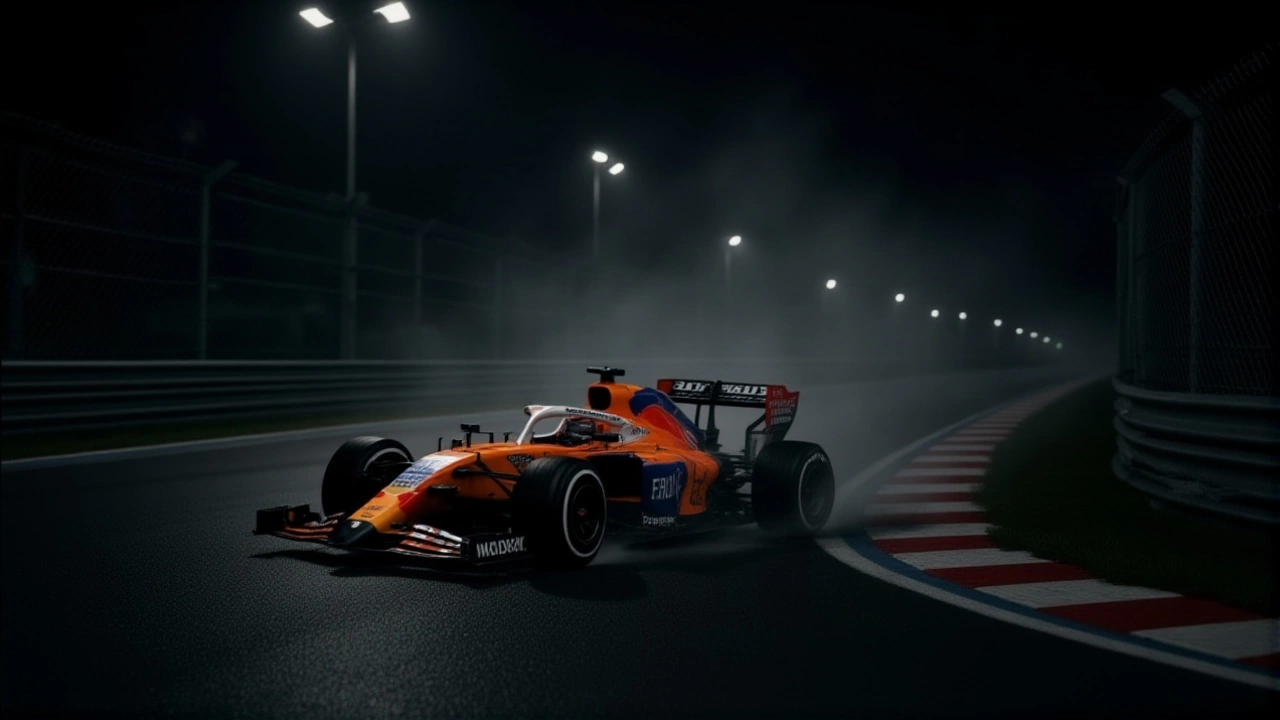The 2025 Las Vegas Grand Prix Las Vegas Strip Circuit delivered what Formula 1 officials called the "worst conditions ever" during qualifying — not because of a storm, but because of a perfect storm of design, climate, and urban decay. On Friday, November 21, 2025, drivers wrestled with cold asphalt, oily roads, and corners so far apart they couldn’t warm their tires. The result? A qualifying session that felt more like a science experiment than a race. And it wasn’t just bad luck — it was baked into the track’s DNA.
The Track That Can’t Keep Warm
The Las Vegas Strip Circuit is a paradox. A mile-long straight stretches from the Bellagio fountains to the Caesars Palace sign — perfect for top speeds, terrible for grip. Then, abruptly, you hit a 90-degree corner with barely 15 seconds to brake, turn, and accelerate before the next one. That’s not a challenge — it’s a trap. Esteban Ocon, driver for Haas F1 Team , put it bluntly: "No, whatever tarmac you put on, it’s always going to be tricky. There are no corners, so we don’t put heat into the tyres. That’s the problem."
On a normal circuit, drivers can weave, brake hard, and flick the car to generate friction. Here, the long straights force them to cruise. The tires — especially the soft Pirelli C3, C4, and C5 compounds selected for this event — never reach optimal operating temperature. Without heat, they don’t stick. And on a surface already slick with decades of oil residue from daily traffic? You’re driving on grease.
The Grease on the Street
Pirelli knew this was coming. Mario Isola, Pirelli’s Head of Formula 1 , confirmed during his Thursday briefing that the track was "greasy" when inspected on Wednesday. That’s not an exaggeration. The Strip is a public road — open 24/7 to taxis, delivery vans, and tourists in Teslas. Every car that rolls over it leaves behind a film of rubber, oil, and brake dust. Rain doesn’t wash it away — it just turns it into a slick, invisible hazard.
Unlike sealed race tracks like Silverstone or Spa, this circuit resets every day. There’s no overnight track prep. No rubber build-up. No dedicated cleaning. And with ambient temperatures hovering in the mid-50s Fahrenheit, the asphalt never warmed up enough to help. "We know that the track is going to be open every day," Isola said. "So there is a sort of reset compared to other tracks that stay closed."
Rules That Made It Worse
2025 brought new wet-weather rules meant to improve safety — but they didn’t fix the core problem. Pirelli introduced new full-wet tires, claimed to be "up to two seconds per lap faster," with stiffer construction to resist overheating. Drivers got an extra set. They were no longer forced to use two slick compounds in wet races. But here’s the catch: the race itself was dry. The qualifying rain passed by 7:30 PM. The track dried quickly. The new tires? Unused. The real issue remained: tire temperature management.
Meanwhile, the mandatory two-pit-stop rule — regardless of weather — added another layer of complexity. Teams couldn’t gamble on conserving tires. They had to pit, even if the tires were fine. That meant extra wear, extra strategy risk, and more time lost in the pits — where the 20-second stop penalty (including the mandatory 2.5-second hold) could cost a podium.

Who Paid the Price?
Qualifying was chaotic. Drivers locked up, spun, and ran wide — but only one made contact with the wall. The FIA’s forecast had predicted "only a slight chance of one light shower," and that’s all they got. Still, the damage was done. The track was too cold, too greasy, too unforgiving.
Then came Saturday. Dry. Cold. Still greasy. And Max Verstappen, driver for Oracle Red Bull Racing , won. Again. Despite calling Las Vegas "a mirage of faux opulence," his car’s superior downforce and tire control carried him through. Meanwhile, McLaren Racing Ltd. suffered double disqualifications. Why? Their cars’ skid blocks — the wooden planks under the chassis — wore down too much. Officials admitted it wasn’t driver error. "Mitigating circumstances," they said. "A bumpier surface that induced bouncing and a lack of uninterrupted dry-weather running in practice."
That’s the cruel irony. The circuit’s roughness — from decades of city traffic — didn’t just hurt the cars. It punished the teams who couldn’t simulate it.
What’s Next for Street Circuits?
Formula 1 loves street circuits. Monaco. Singapore. Baku. But Las Vegas is different. It’s not a historic city center. It’s a highway with neon lights. And it’s exposing a flaw in modern F1: the assumption that any surface can be made race-ready.
Jolyon Palmer, former Renault F1 driver and current analyst , nailed it: "The long straights will necessitate slashing the downforce levels, so the cars will feel inherently skittish before you even factor in the cool temperatures."
Teams will now have to develop new simulation models for public-road circuits. Pirelli may need to redesign tires for low-grip, low-temperature environments. And the FIA? They’ll have to decide: is Las Vegas worth the risk? Or should they demand a dedicated track surface — even if it costs millions?

Historical Echoes
Las Vegas hosted F1 races in 1981 and 1982 at Caesars Palace — a temporary circuit on a parking lot. Back then, the cars were slower, the tires were different, and the city didn’t have 200,000 vehicles rolling over the same asphalt every day. The old races were quirky. The 2025 race was dangerous. And it wasn’t an accident.
Frequently Asked Questions
Why couldn’t teams simulate the track conditions in practice?
Teams rely on data from previous sessions to tune setups, but the Las Vegas Strip Circuit resets daily. With no dedicated track time between sessions and constant vehicle traffic, the surface changed between FP1, FP2, and qualifying. Even the most advanced simulators couldn’t replicate the greasy, cold, inconsistent grip — making setup decisions largely guesswork.
How did Pirelli’s new wet tires impact the race?
They didn’t — not directly. The rain stopped before the race, so the new full-wet tires were unused. But their development highlights a shift: Pirelli is now designing for extreme conditions, not just rain. The stiffer construction and heat resistance could influence future tire choices at cold-weather street circuits like Singapore or Baku, even when dry.
Why did McLaren get disqualified for plank wear?
McLaren’s cars bounced excessively due to the circuit’s uneven surface — a result of decades of city traffic and poor maintenance. With no dry practice sessions to fine-tune ride heights, teams couldn’t adjust suspension settings properly. The plank wear was outside normal limits, and while officials acknowledged the track’s role, F1 rules don’t allow exceptions — even for bad conditions.
Is the Las Vegas GP likely to return in 2026?
Yes — but pressure is mounting. The event draws massive crowds and TV ratings. However, after the 2025 qualifying chaos, F1 insiders say the circuit’s surface must be upgraded. Possible solutions include sealing the road with a dedicated racing compound or installing temporary asphalt overlays. Without changes, the race risks becoming a safety liability, not a spectacle.
What makes this different from Monaco or Singapore?
Monaco and Singapore are closed circuits with dedicated cleaning crews and minimal public traffic. Las Vegas is a public highway. The surface isn’t maintained for racing — it’s maintained for cars, buses, and delivery trucks. That means oil, debris, and inconsistent grip. No other F1 street circuit has this level of daily urban contamination.
Could this happen at another street circuit?
Potentially. Any city with high traffic volume and cold weather — like Detroit, Miami, or even a future European street race — could face similar issues. The 2025 Las Vegas GP is a warning: F1’s love affair with street circuits can’t ignore infrastructure realities. The track isn’t just the asphalt. It’s the city around it.





